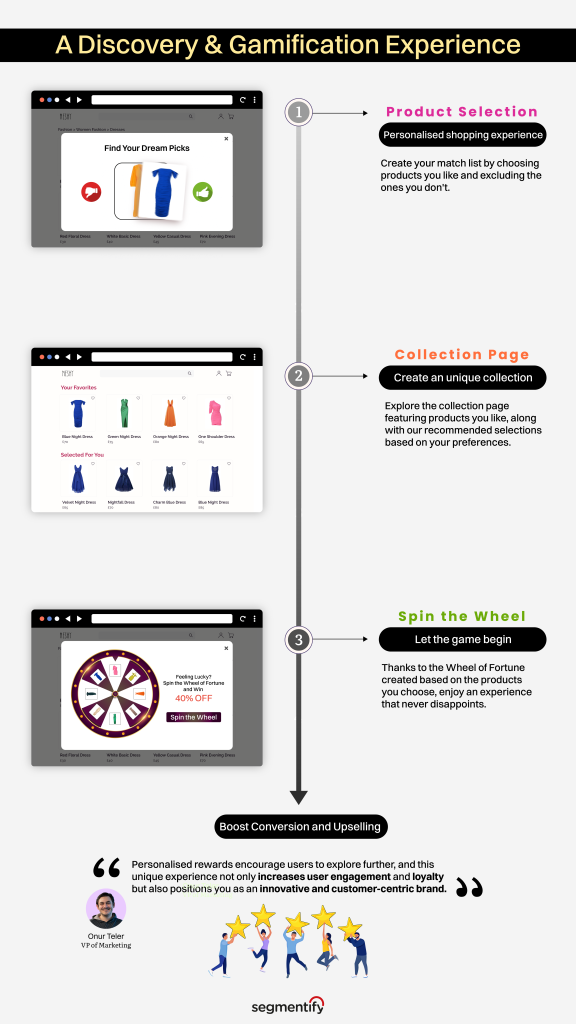Our websites use cookies. By continuing, we assume your permission to deploy cookies as detailed in our Privacy Policy.
The Ultimate Guide to Gamification in Marketing
Whether it’s the thrill of conquering a virtual realm or the satisfaction of unlocking new levels, the allure of games is universal and timeless.
This intrinsic love for games has birthed an ingenious digital marketing strategy — a secret weapon for increasing brand awareness and customer engagement.
Key Takeaways
- Gamification is more than a trend; it’s a transformative approach that taps into the core of human psychology, offering personalised rewards and customised experiences.
- From boosting user engagement and brand awareness to collecting data in a non-intrusive manner and increasing conversion rates, the incorporation of game elements into your marketing efforts can lead to impressive results.
Imagine infusing the excitement of a game into your marketing efforts, where every interaction becomes an engaging challenge and each purchase transforms into a rewarding achievement!
This article will explore the benefits of gamification in marketing, explain how to implement gamification in marketing, and will discuss different gamification marketing examples with step-by-step scenarios.
Ready, set, go!
What is Gamification in Marketing?
Utilising game design elements and mechanics, gamification in marketing effectively captivates and propels individuals towards specific actions by leveraging incentives like rewards, badges, points, and leaderboards. This prevalent marketing approach seamlessly embeds game dynamics into diverse arenas like websites, apps, and social media platforms.
Unlock triumph with gamification marketing, your exclusive key to success! Download eCommerce Gamification Marketing Guide now to master its strategic application.
6 Benefits of Gamification in Marketing
Let us delve into the captivating realm of gamification, exploring its multifaceted benefits that extend beyond mere entertainment. Prepare to unlock the next level of customer engagement and brand loyalty through the strategic fusion of playfulness and marketing prowess.
1. Increases User Engagement
Engaging today’s tech-savvy and easily-distracted consumers is a perpetual challenge. Marketing gamification provides a unique solution by turning routine interactions into enjoyable experiences.
By integrating game elements such as challenges, rewards, and leaderboards, brands can captivate their audience’s attention and keep them actively participating. This heightened engagement translates into extended interaction periods with your brand, leading to deeper connections and enhanced recall.
2. Builds Brand Awareness
In a cluttered digital environment, breaking through the noise and making your brand memorable is crucial. Incorporation gamification in marketing allows you to create interactive experiences that stick in the minds of consumers.
Through memorable games and challenges, your brand’s identity becomes intertwined with positive emotions and enjoyable moments. As players share their experiences with friends and family, your brand’s reach expands, leading to increased brand awareness.
3. Zero-Party Data Collection in a Non-Intrusive Way
While data is probably one of the most valuable assets for a business, concerns over data privacy have prompted a shift towards more transparent and consensual data collection methods.
From Apple’s App Tracking Transparency updates to the introduction of GA4 and cookieless tracking by Google, brands have been taking more responsibility in data privacy and transparency.
Implementing gamification in marketing offers an unobtrusive way to gather valuable insights through zero-party data collection. Players willingly provide information as they engage with games, surveys, or interactive quizzes. This approach fosters trust and allows brands to personalise marketing efforts effectively, all while respecting user preferences and privacy.
4. Increases Conversion Rate
Converting leads into paying customers is the ultimate goal of any marketing campaign and gamification has shown to be a potent conversion booster.
By integrating compelling game mechanics into your sales funnel, you guide users seamlessly through the buyer’s journey. As players engage with your “games”, they become more emotionally invested, making them more likely to complete a desired action, whether it’s making a purchase, signing up for a newsletter, or requesting a demo.
5. Makes Promotions More Interesting
Traditional promotional methods can often feel repetitive and uninspiring. Implementing gamification in marketing, on the other hand, injects an element of excitement into promotions by adding an element of surprise and challenge.
Whether it’s a Spin the Wheel game, a digital scavenger hunt, or a trivia contest related to your products or services, gamified promotions capture attention and encourage participation, leading to a more engaging and enjoyable promotional experience.
6. Educates Customers About Your Products and Services
Complex products or services can be challenging to explain effectively. Implementing gamification in your marketing presents a creative solution by transforming the learning process into an engaging adventure.
Interactive simulations, quizzes, and tutorials presented as games make it easier for customers to grasp complex concepts. This not only increases their understanding but also leaves a lasting impression, making them more likely to remember and consider your offerings even if they don’t convert right away.
How to Implement Gamification in Marketing
Gamification has emerged as a powerful strategy in marketing, offering a unique approach to customer interaction that can drive brand loyalty, increase conversions, and create memorable experiences.
Pay extra attention to these steps while implementing gamification in your marketing strategy to ensure the best results:
- Determine your goals: Before diving into gamification, clearly outline your marketing objectives. Are you looking to boost customer engagement, increase brand awareness, drive sales, or build your email list? Defining your goals will help you tailor your gamification efforts to align with your overall business strategy.
- Understand your audience: Effective gamification relies on a deep understanding of your target audience. What are their preferences, behaviours, and motivations? Gather insights through tools like Trendify to identify the elements of gamification that will resonate most with your audience.
- Choose game mechanics: Consider elements such as points, badges, leaderboards, challenges, virtual rewards, and progress tracking. The mechanics you choose should align with your objectives and appeal to your audience’s interests.
- Integrate gamification into your existing marketing channels: Gamification shouldn’t exist in isolation—it should seamlessly integrate into your existing marketing channels. Whether it’s your website, social media platforms, mobile app, or email campaigns, ensure that the gamified elements enhance the overall user experience and support your brand messaging.
- Set clear rules and progression paths: Clearly communicate the rules, objectives, and progression paths to participants. Provide them with a sense of purpose and direction as they navigate through the gamified elements. Transparency fosters trust and ensures a fair playing field.
- Design for UX: Ensure that the gamified interface is intuitive, visually appealing, and easy to navigate. A seamless and enjoyable UX will encourage participants to stay engaged and continue interacting with your brand.
- Monitor and analyse performance: Implementing gamification is not a one-time thing. Continuously monitor the performance of your gamified campaigns. Collect data on user interactions, engagement levels, conversion rates, and other relevant metrics. Analyse this data to identify areas of improvement and refine your gamification strategy over time.
Gamification Marketing Examples
Whether you’re looking to capture the interest of first-time visitors or re-engage abandoning users through exit intent strategies, gamification can be a powerful tool in your marketing arsenal.
Let’s go over different gamification marketing scenarios and see how gamification marketing works in action:
Reduce Exit Rate with Gamification
- Identify key exit points: Before you can implement exit intent gamification, identify the key exit points on your website, landing page, or app. These are moments when visitors are about to leave without taking the desired action, such as making a purchase or subscribing to a newsletter.
- Create an engaging game overlay: Develop a captivating game overlay that appears when users attempt to exit the page. This overlay could feature a simple yet addictive game that ties into your brand or product. An eCommerce site could use a Spin the Wheel pop-up offering discounts or free shipping codes.
- Reward engagement: If you’re trying to reduce exit rates, rewards should incentivise users to stay longer on site. Continuing with the eCommerce example, the rewards should have time limits to encourage the users to continue with product exploration and make a purchase.
- Direct the users to take action: Integrate a call-to-action (CTA) within the game overlay to direct users toward the desired conversion. If you want the user to use the discount they’ve just won, use an “Add to cart” button so that the product they were just looking at that triggered the exit intent pop-up because they were about to leave the page is added to their cart right away. In other words, match the end action to your goal in the beginning.
Abandoned Cart Recovery with Gamification
- Identify cart abandonment segments: Not every abandoned cart is the same. Using platforms like Segmentify, identify different sets of Dynamic Segments for different cart abandonment scenarios. Do you want to target high-value carts, carts with cross-selling potentials, or abandoned carts containing specific products?
- Use personalised emails: Set up personalised email marketing campaign flows for different cart abandonment segments that not only reminds them of the items left behind but also introduces a gamified element to get them back to the website or app.
- Unlocking the rewards: Encourage users to complete their purchase by offering them discounts or exclusive offers upon successful completion of the game. Make sure the rewards are enticing enough to motivate that specific segment to return and finalise their transaction.
- Reinforce urgency: Highlight the limited-time nature of the unlocked reward, emphasising that it’s valid only for a certain period. This sense of urgency encourages swift action, pushing the user to finalise their purchase sooner rather than later.
Loyalty Program Enhancement with Gamification
- Assess current loyalty program: Evaluate your existing loyalty program and identify areas where gamification elements can be seamlessly integrated. This could include point-based systems, tiers, or rewards for specific actions like referrals, social sharing, and repeat purchases. If you don’t have a customer loyalty program at the moment, work on its design with gamification in mind.
- Encourage regular use: Create interactive challenges or missions that members can complete to earn extra rewards or move up to higher tiers. These challenges could involve tasks like logging onto their account everyday for a predetermined period, completing a certain number of transactions, engaging with your brand on multiple platforms, leaving reviews, or participating in user-generated content campaigns.
- Showcase progress: Allow members to track their progress and see how close they are to unlocking the next reward or tier. This visual representation of progress can motivate them to remain engaged and continue participating in your loyalty program.
First-Time Visitor Engagement with Gamification
- Collect email addresses: Use straightforward gamification designs like Spin the Wheel or Scratch-off to encourage the first-time visitors to join your email list.
- Send welcome emails: Send warm welcome emails to newcomers. Design the email to include interactive elements such as surveys, quizzes, or preference-based challenges. Encourage visitors to participate by providing valuable insights about their preferences, interests, and needs.
- Progressive data collection: Utilise progressive customer profiling techniques to collect additional data with each interaction. As visitors engage with subsequent emails or landing pages, gradually build a more comprehensive profile that informs your personalization efforts.
- Personalise incentives: Based on the data collected, personalise the incentives you offer in follow-up emails. Tailor content recommendations, discounts, or exclusive offers to align with each visitor’s expressed preferences, increasing the likelihood of engagement.
- Segment content delivery: Segment your email list based on the data gathered, creating targeted content streams that resonate with specific user interests. Deliver content, promotions, and product recommendations that genuinely appeal to each segment.
- Conversion-oriented follow-up: Craft follow-up emails that strategically guide visitors toward conversion actions. Whether it’s making a purchase, signing up for a trial, or exploring a specific product category, customise the messaging to align with their journey.
Zero-Party Data Collection with Gamification
Rather than just collecting email addresses, you can use gamification to collect other kinds of zero-party data without bothering and pestering your users.
How?
See for yourself 👇
- Ask the users to swipe right: The most straightforward way to find out what your customers like is to just ask them. We’ve decided to spice things up with a Tinder-inspired game, in our example.
- Create personalised collections: Create a collection with the items the user swiped right. But here’s where things get interesting; include personalised recommendations in the collection based on what the customer told you during the little Tinder-inspired game.
- Craft another game: Now that you know what they’re interested in, hit ‘em with another game—spin the wheel. They’re already interested in a bunch of products because they have seen them, either because they specifically selected them or the algorithm made personalised selections based on what they chose in the first step.
- Encourage further engagement: Create a good old fashion Spin the Wheel game using these products. Since they’re already interested in them, they will be more likely to use their discount codes! However, don’t trigger this second gamification campaign right after the other. Give 2-3 days before this second game is triggered.

Wrapping Up
Integrating gamification in marketing has transcended being a mere trend to become a transformative strategy rooted in human psychology. Gamification not only offers an engaging way to interact with customers but also serves as a powerful tool for achieving various marketing objectives.
To implement gamification successfully, you need a strategic approach involving clear goals, audience insights, thoughtful mechanics, seamless integration, and user-centric design. By continuously monitoring and adapting, businesses can tap into gamification’s potential to captivate, convert, and foster customer loyalty—a bridge between playfulness and strategic marketing prowess.
Ready to harness gamification’s power? Contact Segmentify now for expert guidance, turning every customer interaction into an enthralling journey that enhances brand loyalty and drives conversion rates.





